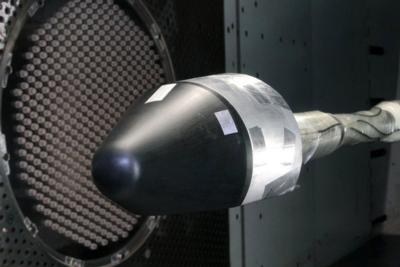Sat, Apr 28, 2012
Wind Tunnel Experiments Validate Aerodynamic Qualities For Re-Entry
Blue Origin, which normally shuns the attention of the media, said Thursday it has successfully tested the design of its next-generation Space Vehicle, completing a series of wind tunnel tests to refine the aerodynamic characteristics of the spacecraft’s unique biconic shape. The tests were carried out as part of Blue Origin’s partnership with NASA under the agency’s Commercial Crew Development (CCDev) program. Blue Origin is designing the Space Vehicle to provide safe, affordable transport of up to seven astronauts to low-Earth orbit and the International Space Station.

“Our Space Vehicle’s innovative biconic shape provides greater cross-range and interior volume than traditional capsules without the weight penalty of winged spacecraft,” stated Rob Meyerson, president and program manager of Blue Origin. “This is just one of the vehicle’s many features that enhance the safety and affordability of human spaceflight, a goal we share with NASA.”
The wind tunnel tests validated Blue Origin’s analysis of the Space Vehicle’s aerodynamics during descent through the atmosphere and the ability to change its flight path, increasing the number of available landing opportunities each day and enhancing the vehicle’s emergency return capability. More than 180 tests were conducted over the past several weeks at Lockheed Martin’s High Speed Wind Tunnel Facility in Dallas.

Under CCDev, Blue Origin is maturing the design of the Space Vehicle, including its aerodynamic characteristics, culminating in a System Requirements Review in May of this year. Blue Origin will conduct tests of its pusher escape system later this year, demonstrating the ability to control the flight path of a subscale crew capsule using an innovative thrust vector control system. Also under CCDev, Blue Origin is conducting tests of the thrust chamber assembly (TCA) for the BE 3 100,000-lbf liquid oxygen, liquid hydrogen rocket engine, which was recently installed on the E 1 complex test stand at NASA’s Stennis Space Center.
Blue Origin is backed financially by Amazon.com founder Jeff Bezos. (Images provided by Blue Origin)
More News
About 2132 And At 11,800 Ft MSL, The Airplane Began A Rapid Right Spiraling Descent On August 18, 2025, about 2133 central daylight time, a Lancair NLA-275-FR-C airplane, N345LA, w>[...]
Aero Linx: The Collings Foundation The Collings Foundation is a non-profit, Educational Foundation (501(c)3), founded in 1979. The purpose of the Foundation is to preserve and exhi>[...]
"This first FAA certification enables us to address the pilot shortage crisis with modern training solutions. Flight schools need alternatives to aging fleets with 40-year-old desi>[...]
North Atlantic High Level Airspace (NAT HLA) That volume of airspace (as defined in ICAO Document 7030) between FL 285 and FL 420 within the Oceanic Control Areas of Bodo Oceanic, >[...]
“HITRON embodies the Coast Guard’s spirit of innovation and adaptability. From its humble beginnings as a prototype program, it has evolved into a vital force in our co>[...]
 NTSB Prelim: Lancair NLA-275-FR-C
NTSB Prelim: Lancair NLA-275-FR-C ANN's Daily Aero-Linx (09.12.25)
ANN's Daily Aero-Linx (09.12.25) Aero-News: Quote of the Day (09.12.25)
Aero-News: Quote of the Day (09.12.25) ANN's Daily Aero-Term (09.12.25): North Atlantic High Level Airspace (NAT HLA)
ANN's Daily Aero-Term (09.12.25): North Atlantic High Level Airspace (NAT HLA) Aero-News: Quote of the Day (09.13.25)
Aero-News: Quote of the Day (09.13.25)




